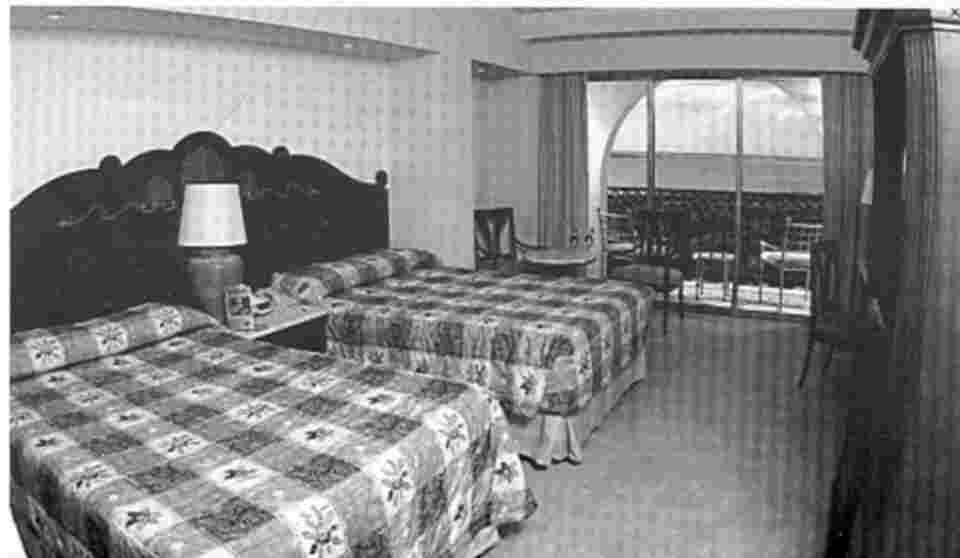 |
|
|
Bouzouki Week 2006 |
|
|
The Greek-American Review invites its readers to join the group of the sister publication, Estiator, for a week in Cancun, Mexico, January 23-30. We will be staying at the five star Grand Solaris, the newest resort in Cancun. This is the BOUZOUKI WEEK in the Caribbean, organized by Estiator every year, since1989.
|
We invite you to join us for a great
week of relaxation and Greek Glendi every night with excellent Greek performers, exclusively for the Estiator Group. We advise our readers to make their reservations as early as possible, in order to avoid paying more after we sell our allotment at group rates. |
|
A General View of Cancun |
|
|
No more than 30 years ago Cancun was merely a peculiar geological formation called a sand rear-clinging to Mexico's Caribbean coast. Until keen-eyed developers in the 1970s saw the appeal of the area's shimmering turquoise waters and sparkling white sand, it had remained largely untouched since the mysterious decline of the Mayan empire around the13th century. Today Cancun is a favorite Caribbean playground and gateway to the Mundo Maya, or Maya World, hosting more than 3 million visitors a year. In the beginning, travelers were drawn only to its crystal clear waters and talcum soft sand. But soon its proximity to breath taking Mayan ruins, exotic wildlife, and colonial gems became added attractions. Cancun serves as an ideal coastal base from which to explore numerous remnants of the extraordinary Mayan civilization that flourished in the Yucatan Peninsula more than a thousand years ago. Nearby are the ruins of Chichen-Itza, Tulum and Coba. Archaeology buffs will want to visit the more distant sites of Uxmal, Labna, Sayil and Kabah-all part of Western Yucatan's Puuc Route-located outside Merida. Colonial towns such as Valladolid, Izamal and Merida are also worth visiting. There are seven species of heron and four of egret that fly Cancun's skies. You can also spot magnificent frigate birds, cormorants, wood storks and white ibis. Iguanas are regularly seen sunning themselves by the side of the road, and in the evenings you can spot crocodiles gliding across the surface of the lagoon. The mangroves lining the lagoon are home to gray squirrels, collared anteaters, weasels, gray foxes and raccoons. Magnificent beaches combined with unique historical sites, some of the best snorkeling and diving in the world, and tropical flora and fauna give Cancun an added dimension.Technically, Cancun's L-shaped Hotel Zone is an island unto itself. It is separated from the mainland at each end by channels less than 100 yards across that connect the beautiful 18-square-mile Nichupte Lagoon with the sparking Carbbean Sea. Each channel is crossed by a low bridge. |
|
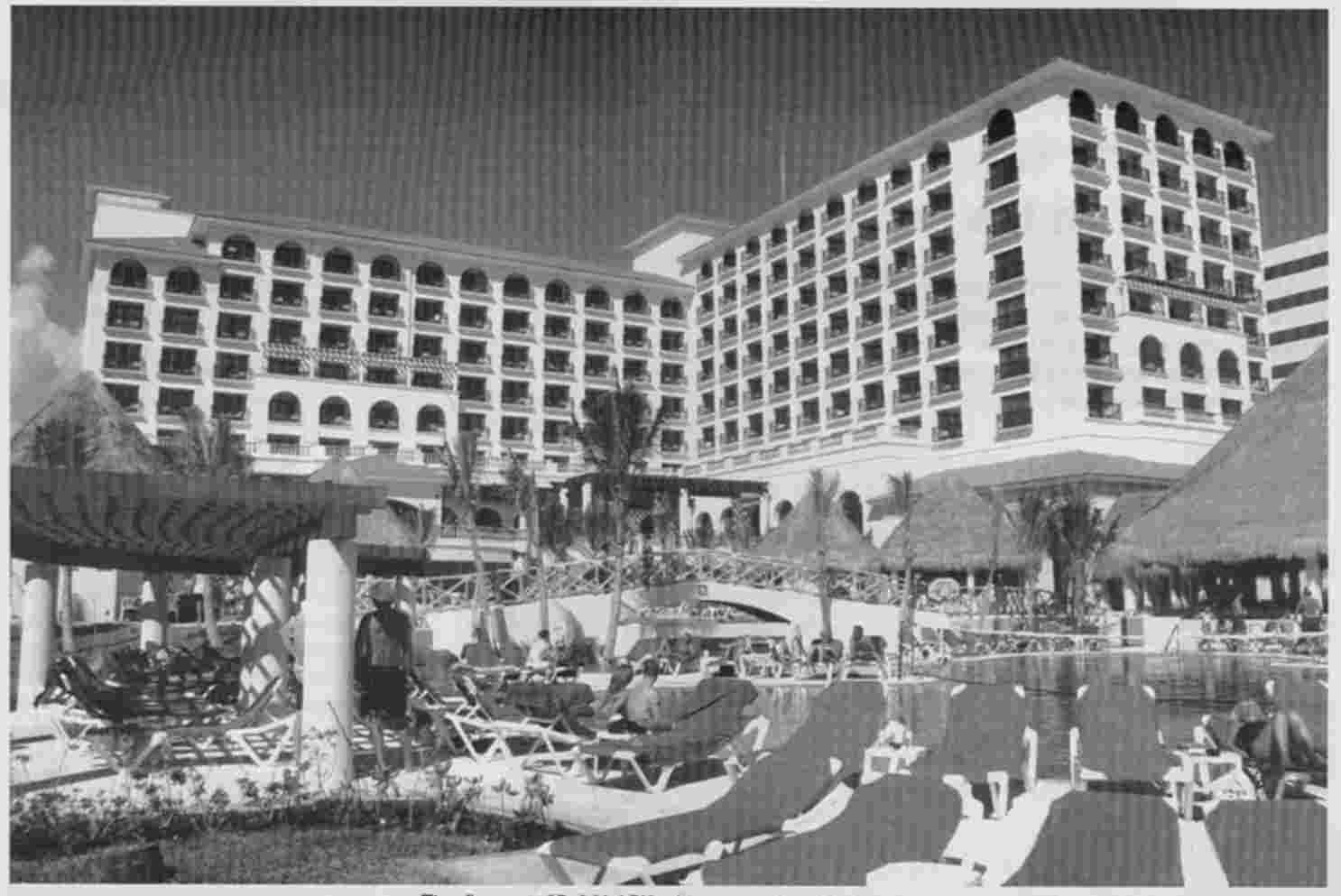 The Five Star GR Solaris, the newest hotel in Cancun |
|
 Singer Gabriel entertaining Estiator's guests in the Dominican Republic in January |
|
|
The island is a coral-based sand bar more than 13 miles long and one-quarter of a mile wide. The sand isn't just soft and brilliantly white, but composed of age-old porous limestone that is comfortable to lie on and never gets too hot. The aerated fossil grains are cool to the touch even at high noon, but so fine that they can easily cling to the skin (talcum powder helps rub them off). There are some intimate coves around the island, spectacular limestone rock formations, and sand dunes up to35 feet high. Cancun has an average of more than 200 sunny days a year and has less annual rainfall than the Virgin Islands or the Bahamas. While it is not directly within the Caribbean hurricane belt the old Mexican adage "hurricanes have no helm" sometimes applies. You may run into some rain, overcast weather and days with bothersome windgusts. Usually a light breeze blows across the island, keeping things cool. |
|
What to wear? Strictly casual resort wear, especially during the day. Jackets and ties are never needed, but it is customary to dress up for the discos, and most nice restaurants and bars require men to wearshirts and slacks (some allow Bermudas). Most frown on sandals. Women are allowed more leeway. but would likely feel underdressed in tank tops and flip-flops. Downtown Cancun is where most of the resort's 730.000 residents live. |
|
| Patterned more after a U.S. suburb than a typical Mexican town, the area is sprawling and easier to negotiate by car than on foot. You can stroll down Avenida Tulum, where many sidewalk stands sell Mexican souvenirs and handicrafts, and visit the neighborhood park, Palapas. Taxis are plentiful, with reasonable pre-determined fares; taxis stationed outside hotels may apply higher rates. Every few minutes, 24 hours a day, white buses barrel up and down Kukulcan Boulevard on their way to and from downtown Cancun, passing all die major shopping centers and hotels along the way. The fare is nominal. A Planned Resort Cancun is the product of a long-range government plan to turn tourism into a major industry. The strategy calls for identifying coastal locations with resort potential and then orchestrating their development as opposed to letting them happen naturally. A special government agency called Fonatur was set up and given the responsibility of scouting for sites, drawing the master plans, soliciting private and foreign investment supervising development and promoting the outcome. The coastline stretching from Cancun toTulum, called the Riviera Maya, is now booming. The area is home to the beach town of Playa del Carmen, the Sian Ka' an nature reserve, and tropical parks Tres Rios, Xcaret and Xel-Ha. New hotels, from sprawling all-inclusives to intimate inns, open regularly and a four-lane highway is nearing completion. Cancun's greatest attractions are its stunning beaches and swimmers have a variety to choose from. Most hotel beaches are excellent so try several, particularly on the other end of the Hotel Zone from where you are staying. Beaches in Mexico are government property and therefore open to the public. Archaeological Sites A trip to Cancun should include a visit to one of the famous nearby archaeological sites. A miniature sample of these sites is right on Cancun island. The Ruinas del Rey, or King's Ruins, which border the lagoon on the south end of the island, date back to the Late Pre-Classic period (300 B.C.-l 00 A.D.). The site's original Mayan name is uknown; it derived its current name from the discovery of a stone figure whose headdress and ear plugs were believed to depict a person of high ranking. Though minor compared to other sites, Del Rey did reveal something of the way its inhabitants lived, subsisting primarily from fishing and mollusk gathering. They also developed a far-reaching trade system that bartered seafood, and conch and snail shells used to make utensils and ornaments, for imported items such as grinding stones and flint knives. The stone figure and other artifacts, including conch and hadeite ornaments, have been removed, but visitors can still see remnants of a mural painting, glyphs,and human figures painted in red, black, yellow and blue. Artifacts from this and other sites in the state reside in the small Musem of Cancunat the Convention Center. The museum is open 9 a.m. to 7 pm. daily. |
|
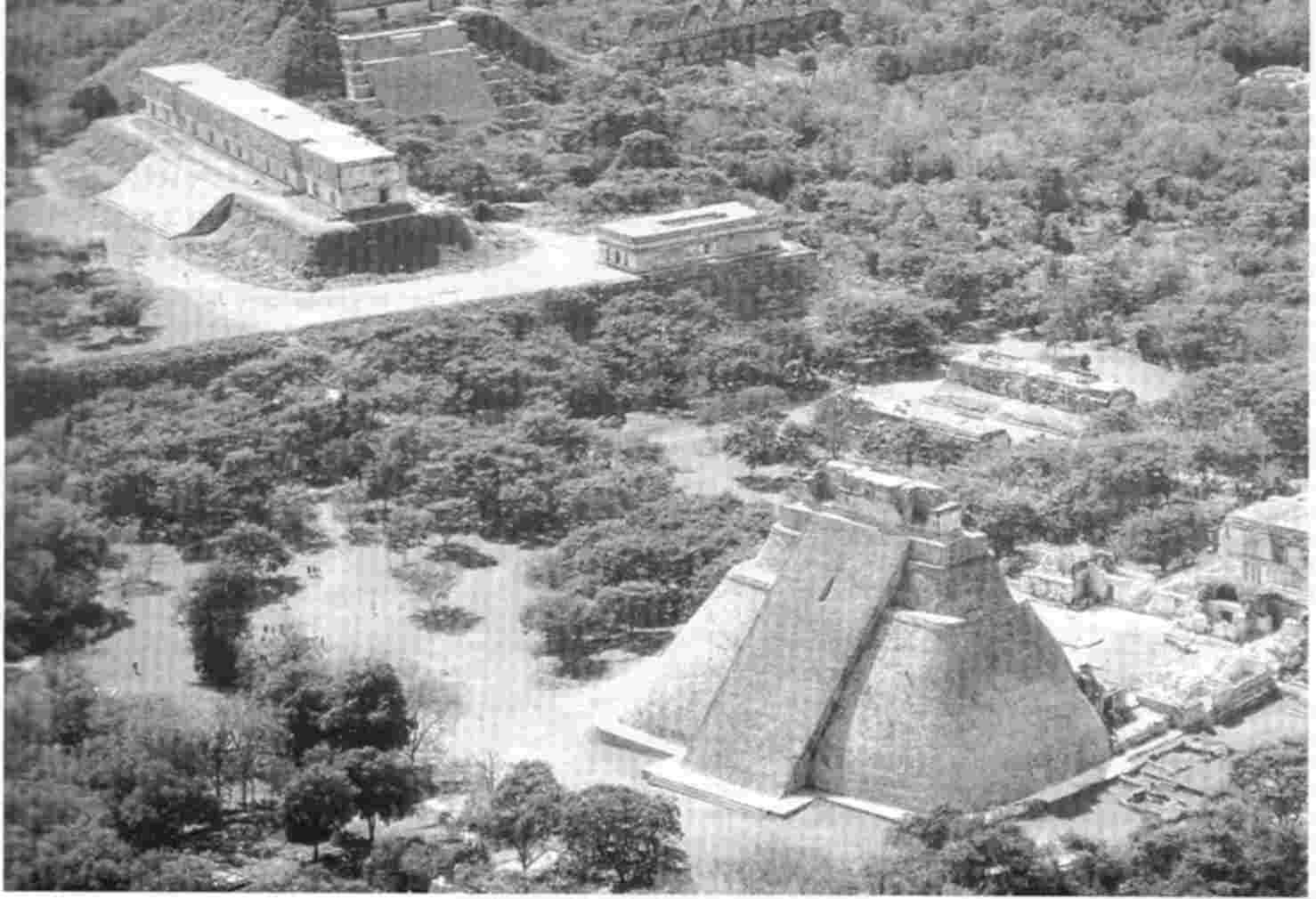 The Mayan city of Uxmal dominated the Puuc region of Yucatan during the Late Classic period between 600-1000 A.D. |
|
|
Only two and a half hours from Cancun, toward Merida, is one of the most impressive of all Mayan ruins, Chichen-Itza.
The site dates to the Classic period, around 600 to 900 A.D., but most of the structures for which Chichen-Itza is renowned date from the Toltec-Maya, or Post-Classic period (900 to 1200 A.D.) Near Chichen-Itza are the Balankanche Caves, the major portion of which remained sealed until the middle of this century, protecting the secrets Mayan priests left inside. There are light and sound shows at both Chichen-Itza and Balankanche. Fifty miles south of Merida are several smaller Mayansites, among them Uxmal, Kabah Sayil and Labna. For more information, refer to the Merida chapter. A little beyond is Loltun Cave, a huge cavern left much as nature created it with little commercialism. other than guided tours and minimal footpaths. The Mayan civilization extended through Central America, so more archaeological treasures lie across Mexico's southern border, in neighboring Guatemala and Belize and in Honduras and EI Salvador. One and two-day tours are available from Cancun to Tikal in Guatemala, and two-day tours to Copan in Honduras. Once a bustling city of 55,000, the Late Pre-Classic site of Tikal is famed for its set of twin pyramids that face each other across vast plazas. The area's wildlife nearly rivals the ruins as an attraction; in fact Tikal is located within a national park. Copan features a unique, magnificently carved staircase, dedicated in 755 A.D., that records the history of 17 rulers of the royal dynasty. The site is believed to have flourished for more than a thousand years and served as a center of learning. Many interesting sites and locations near Cancun are reachable by boat and these trips often combine sightseeing with snorkeling. One of the most popular day trips for nature lovers is to Isla Contoy, a protected breeding colony for nearly 100 species of seabirds, among them double-crested cormorants, roseate spoonbills and frigate birds. On the island, located about an hour and a half by boat from Cancun, visitors can take a guided walking tour, explore the beaches, snorkel. and visit theopen-air museum on the area's wildlife. Isla Mujeres is a great day trip or over-night jaunt. You can ferry over from either Puerto Juarez or Punta Sam for a nominal fee-both ports are about 10 minutes north of downtown Cancun (the car ferry runs from Punta Sam, which is about 5 minutes farther along on the same road after you pass Puerto Juarez). Cozumel is a 15-minute flight from the Cancun International Airport or a five-minute flight from Playa del Carmen's airport Or you can ferry over from Playa (most peopledo); the trip takes 45 minutes. Playa del Carmen is a burgeoning beach town about an hour and a half by bus from downtown Cancun. or a 40-minute drive from Cancun's International Airport It isgrowing by leaps and bounds, and is no longer the off-the-beaten-track destination it once was. But Playa's marked European influence, fine eateries, and bustling nightlife make it an interesting spot. About 30 minutes south of Cancun is Puerto Morelos, a small laid-back fishing village that is gradually attracting tourists. It's a favorite snorkeling site since this is where the region's barrier reef comes closest to the coast. See the "Riviera Maya" for more information on these and other sites, including the ruins of Tulum and Coba. Xcaret andXel-Ha, Tres Rios. Puerto Aventuras and Akumal, and the Sian Ka'an nature reserve. Merida, the marvelous colonial capital of the state of Yucatan. is about three hours (320 kilometers/200 miles) west of Cancun on an excellent four-lane highway. The city is a showcase of Yucatecan culture, and especially nice to visit on Sunday, when streets close to traffic and the main square turns into a huge handicrafts market. Other charming colonial towns worth visiting are Valladolid, located just before reaching the ruins of Chichen-Itza. and Izamal. about 30 minutes away from the ruins. Both can be combined with tours of the archaeological site. If you are intrestead call us at 212-967-1564. or 800-662-6644 from outside N.Y.State or you can email us at estiator@estiator.com
|
|
|
NEW DESTINATION FOR BOUZOUKI WEEK DUE TO HURRICANE DAMAGE Bouzouki Week in Riviera Maya An area 55 miles South of Cancun, undamaged by the hurricane Hotel Information Barcelo Maya Beach Resort, a five star hotel built in 1999, is superbly set along a magnificent white sand beach where guests can relax on chaise lounges under the shade of palm trees, and watch the always calm, clear waters of the turquoise Caribbean lap over the offshore reef. The free‑form pool is like a lagoon without borders, buried in a thick oasis of palm trees with a footbridge leading to a huge jacuzzi. After a busy afternoon relax and enjoy breathtaking views of the Caribbean while sipping a cool, tropical drink. Barcelo, as experts on the All‑Inclusive, put emphasis on large dining areas and varied menus that are sure to please every palate. The a la carte Don Quixote Restaurant features meat and seafood delicacies, while the specialty Mexican restaurant Agave (named after the tequila leaf) is decorated with serape covered tables. 1 King Bed or 2 Queen Beds All rooms include complete bathroom with tub and shower, air conditioning, satellite television with remote control, hair dryer, ceiling fan, alarm coffee/tea maker, video game system, minibar with beer and soft drinks replenished daily, terrace or balcony, safety deposit box and direct dial telephone. The Barcelo Maya features five buildings of Mayan‑inspired architecture overlooking 2 km of white sand beach with clear blue waters and a natural coal reef. Surrounded by miles of virgin grounds, each air‑conditioned room has its own terrace. Located on a long stretch of virgin beach, the property features a full spa with Turkish bath, a mini‑golf course surrounding a natural cenote, PADI dive center with an array of non‑motorized water sports, pay‑per‑view and video games in rooms. Beach The resort borders 2 km of white sand beach lined with swaying palm trees. The resort is 40 miles south of Cancun Airport, 15 miles south of Playa del Carmen, and 20 miles north of the Tulum Ruins, near Xcaret and Xel‑Ha. No pets allowed. No spring breakers. Men are required to wear dress slacks, casual elegant dress codes applies to women for dinner dining. A la carte dining two nights with reservations.
Activities & Entertainment Pitch & Putt Mini‑Golf, Aquaerobics, Volleyball, Basketball, Waterpolo, Games, Dancing Courses, Scuba and Water Sports Center. Disco, karaoke, and different shows every night in an impressive split level Mayan‑style amphitheater |
|
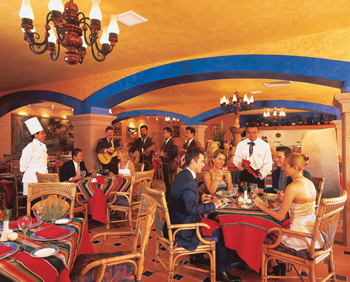 |
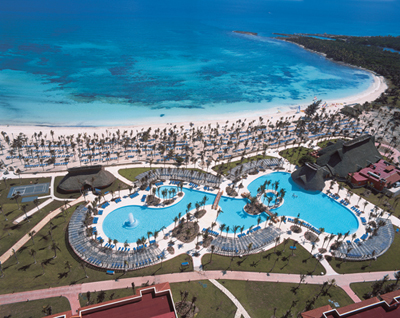 |
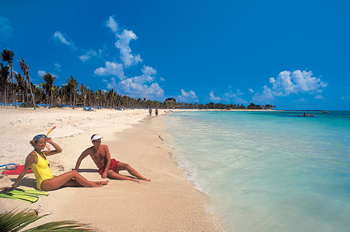 |
|
|
|
|
|
|
|
|
2000 © Hellenic Communication Service, L.L.C. All Rights Reserved. http://www.HellenicComServe.com |
|
